Alfred Drury | |
|---|---|
| Born | 11 November 1856 Islington, London |
| Died | 24 December 1944 (aged 88) Lancaster Lodge, Wimbledon, London |
| Nationality | British |
| Alma mater | |
| Known for | Sculpture |
Edward Alfred Briscoe Drury RA (11 November 1856 – 24 December 1944) was a British architectural sculptor and artist active in the New Sculpture movement. During a long career Drury created a great number of decorative figures such as busts and statuettes plus larger monuments, war memorials, statues of royalty and architectural pieces. During the opening years of the 20th-century he was among the foremost architectural sculptors active in Britain and in that period created the series of works in central London for which he is perhaps now best known. These include the figures on the Old War Office building in Whitehall, elements of the facade of the Victoria and Albert Museum and four of the colossal statues on Vauxhall Bridge.[1][2][3]
Biography
Education and training
Drury was born in Islington, London but raised in Oxford , where his father was a pub landlord.[1] Drury studied at the Oxford School of Art and then at the National Art Training School in South Kensington, where his teachers included Jules Dalou and, later, Édouard Lantéri.[2] Drury won gold medals in National Art Competitions in 1879, 1880 and 1881 before moving to Paris where he worked as an assistant to Dalou until 1885.[2][4] While in Paris he assisted Dalou on the monumental Triumph of the Republic in the Place de la Nation.[5]
When he returned to London, Drury worked as an assistant to the sculptor Joseph Edgar Boehm and began establishing himself as an independent artist.[1][4] In 1885 Drury showed his first work at the Royal Academy, a terracotta copy of a sculpture by Dilou, The Triumph of Silenus.[2] Also during 1885, he had pieces shown at exhibitions in both Paris and Brussels.[4] While his early exhibition pieces, such as 1886s' The First Lesson, clearly showed the impact of his time in France, Drury soon became associated with the British New Sculpture movement.[2] Both Circe, from 1895, and Griselda of 1896 were typical of the allegorical female figures from mythology and literature that were key subjects of the movement and both sculptures were reproduced in several different sizes in bronze and marble by Drury in subsequent years.[2][6]
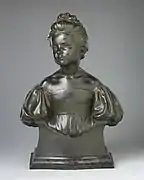 The Age of Innocence, c. 1900
The Age of Innocence, c. 1900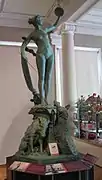 Life-size bronze version of Circe in Leeds City Museum
Life-size bronze version of Circe in Leeds City Museum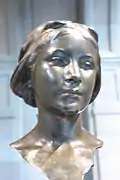 Griselda, c. 1897
Griselda, c. 1897
Early commissions
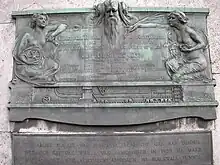
Alongside work on his exhibition pieces, Drury also began undertaking architectural commissions. In 1897, for example, he created a set of terracotta spandrels, representing Art and Design, for a coach builder's premises, now demolished, at Hammersmith in London and is thought to have completed other projects outside of London at this time for which records have been lost.[2] He is known to have completed the two low-relief bronze plaques, featuring the head of a river god and female figures, installed to mark the opening of the Blackwall Tunnel in 1897.[2][7] He collaborated with architect Inigo Thomas on a decorative scheme for the gardens at Barrow Court near Bristol. Tasked with providing sculptures for twelve pillars along a boundary wall, Drury carved a sequence of female heads from a baby to that of an old women to represent the months of the year from January to December.[2]
Drury's original life-size bronze version of Circe was purchased for a park in Leeds and is now in Leeds City Museum. This led to him receiving several commissions in that city, including for the eight lamp standards representing Morning and Evening positioned in Leeds City Square.[2] Drury was awarded a gold medal at the 1900 Paris International Exhibition for a version of Circe and for a bust of a child, The Age of Innocence.[2][8] The art historian Benedict Read considered the latter as one of the 'major icons' of the New Sculpture movement.[8] In 1905, Drury exhibited a new cast of the Evening head titled Spirit of the Night and in 1911 carved a marble version of the statue.[2]
Architect John Belcher hired Drury, and others, to create the external decoration for Electra House at Moorgate in central London in 1902, and he also employed him, the following year, to sculpt external features for the nearby offices of the Royal London Friendly Society in Finsbury Square.[9][2] For the latter scheme, Drury carved several female faces and half-figures including a large keystone figure above the main entrance, consisting of the head of a woman wearing a bronze helmet and framed by oak and ivy branches.[2][10] The model for this composition was shown at the Royal Academy in 1904 and was widely praised.[2][11]
Major works

By 1904, Drury had become established as one of the foremost architectural sculptors active in Britain at the time and this led to the series of commissions for which he is perhaps best known, for the War Office in Whitehall, for the facade of the Victoria and Albert Museum and for Vauxhall Bridge.[2]
For the Old War Office Building on Horse Guards Avenue and Whitehall, Drury created four groups of two seated, twice life-size, female figures in Portland stone during 1904 and 1905. The pairs were The Sorrow of Peace opposite The Winged Messinger of Peace, the Horrors of War against the Dignity of War, Truth and Justice plus Victory and Fame.[2][12] The artistic choices Drury made with the pairings and the amount of detail he incorporated into the carvings drew much attention in the newspaper coverage of the new building. For example, the War pairing contrasted a figure of Minerva holding a sword and shield with a more fearful figure holding a skull while some of the figures had gilded bronze attachments such as Victory who holds a small gilded statuette and Truth who has a gilded mirror. Although the works were 70 feet above street level it was reported that crowds of sightseers gathered to view them.[2]
In late 1904 the London County Council commissioned Drury and F. W. Pomeroy to each create four colossal bronze figures for niches on the piers supporting the new Vauxhall Bridge. For the eastern, downstream, side of the bridge Drury created four female figures representing the Fine Arts, holding a statuette and palette, Science holding a globe, Education and Local Government.[2]

By March 1905 Aston Webb, the architect of the Cromwell Road extension to the Victoria and Albert Museum had commissioned over twenty sculptors to provide statues, carvings and decorations for the facade of the building. Webb allocated what he considered the most prominent areas to Drury and George Frampton.[2] The area over the main entrance arch was assigned to Frampton who created spandrel figures of Truth and Beauty for the space.[13] The area under the arch and the remainder of the main entrance were allocated to Drury. Within the curve of entrance arch he created nine low-relief panels featuring kneeling or crouching female figures holding plaques with gold lettering that when read together form a quotation from Sir Joshua Reynolds.[13] Below the arch, and immediately above the main entrance, is Drury's statue of Albert, Prince Consort and above the arch is his statue of Queen Victoria, carrying a staff and flanked by figures of St George and St Michael.[13] Drury's work was singled out for praise in art press reviews when the overall scheme was completed in 1908. That same year, Webb commissioned Drury to produce a relief panel, of children at play, for the new offices of the Grand Trunk Railway Company in Cockspur Street in central London.[2]
Exhibition record
Drury was elected an Associate of the Royal Academy of Arts in 1900 and a full Academician in 1913.[3][14] He exhibited works at the Academy each year from 1885 to 1942, and at the Royal Scottish Academy between 1903 and 1917.[1] He also showed works at the Aberdeen Artists Society, the Royal Glasgow Institute of the Fine Arts and at Leeds City Art Gallery on a regular basis. He was a member of the International Society of Sculptors, Painters and Gravers and, from 1899, a member of the Art Workers' Guild.[1] In 1932, Drury received the Royal Society of British Sculptors' silver medal for his statue of Joshua Reynolds in the courtyard of Burlington House in London.[15][16]
Personal life
Drury lived and worked at Gunter Grove in Chelsea, London.[17]
In 1900, Drury married the artist Phoebe Maud Turner. The couple had two children, including artist Paul Dalou Drury.[16]
Selected public works
1885–1904
| Image | Title / subject | Location and coordinates |
Date | Type | Material | Dimensions | Designation | Wikidata | Notes |
|---|---|---|---|---|---|---|---|---|---|
 More images |
The Genius of Painting | Victoria and Albert Museum | 1886 | Statuette | Terracotta | 39.5cm | [20] | ||
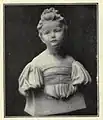 More images |
The Age of Innocence | Victoria and Albert Museum | 1887 | Bust | Plaster | 67.7cm | Several subsequent versions in both marble and bronze exist[8][20] | ||
 More images |
Circe | Leeds City Museum | c. 1895 | Statue group | Bronze | Grade II | Q266566284 | Previously sited at Central Gardens in Park Square and in Leeds City Art Gallery.[2][21][22] | |
 |
Daughters of the Year | Barrow Court, Somerset | c. 1897 | 12 busts on pillars | Stone | Grade II* | Q17533935 | [2][23] | |
 |
Monument to Penn Symons | Victoria Gardens, Saltash, Cornwall | Unveiled 1901 | Relief panel on tapered column | Bronze and stone | Grade II | [24][25] | ||
 More images |
Joseph Priestley | Leeds City Square | 1903 | Statue on pedestal | Bronze and granite | Grade II | Q26655864 | [21][26] | |
 More images |
Morning and Evening | Leeds City Square | 1903 | Eight statues on blocks supporting streetlamps | Bronze and granite | Grade II | [21][27][28] | ||
 More images |
Alexander McLeod (1832–1902) | Former RACS HQ, Powis Street, London | 1903 | Statue in niche | Terracotta | Grade II | [29][30] | ||
 More images |
Queen Victoria | Guildhall Square, Portsmouth | 1903 | Statue on pedestal | Bronze and granite | Grade II | Q26398294 | [21][31] | |
 More images |
1899–1902 South African War Memorial | Clifton College, Bristol | 1904 | Statue, of Saint George, on pedestal | Bronze and Portland stone | Grade II* | Q26678257 | Architects;- WS Paul & RC James.[32][33][34] | |
.jpg.webp) More images |
Queen Victoria | Princes Way, Bradford | 1904 | Statue on pedestal | Bronze and stone | Grade II | Q26425844 | [21][35][36] | |
 |
Lord Byron | Nottingham Castle | 1904 | Bust on plinth | Bronze and granite | [21][35][37] |
1905–1909
| Image | Title / subject | Location and coordinates |
Date | Type | Material | Dimensions | Designation | Wikidata | Notes |
|---|---|---|---|---|---|---|---|---|---|
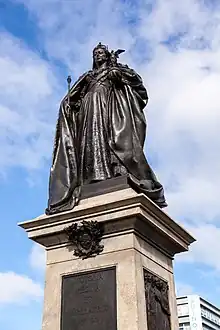 More images |
Queen Victoria | Kent Terrace, Wellington, New Zealand | 1905 | Statue on pedestal | Bronze and stone | Category II | Q79312013 | [38][39] | |
 |
Albert, Prince Consort | Facade of Victoria and Albert Museum, London | c.1905–6 | Statue in niche | Stone | [13] | |||
 |
Queen Victoria, St George and St Michael | Facade of Victoria and Albert Museum, London | 1906 | Statues in niches | Stone | [13] | |||
 More images |
Fine Art, Science, Government & Education | East side of Vauxhall Bridge, London | 1907 | Four statues | Bronze | Grade II* | Q1142134 | [40] | |
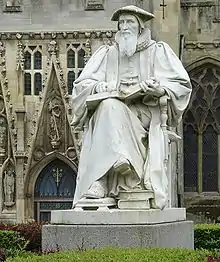 More images |
Bishop Richard Hooker | Cathedral Close, Exeter | 1907 | Statue on pedestal | Marble and granite | Grade II | Q26398018 | [21][41] | |
 More images |
South Lancashire Regiment, Boer War Memorial | Queens Gardens, Warrington | 1907 | Statue on pedestal | Bronze and stone | Grade II | Q26614958 | [42][43][44] | |
 |
South Africa Gate | Queen Victoria Memorial Gardens, The Mall, London | 1908 | Sculpture on pillar | Stone | Grade I | Part of Thomas Brock's Victoria Memorial, London[3][45] |
1910–1919
| Image | Title / subject | Location and coordinates |
Date | Type | Material | Dimensions | Designation | Wikidata | Notes |
|---|---|---|---|---|---|---|---|---|---|
_(October_2012).jpg.webp) More images |
Spencer Cavendish, 8th Duke of Devonshire | King Edward's Parade, Eastbourne | 1910 | Statue on pedestal | Bronze and granite | Grade II | Q26636085 | [21][46] | |
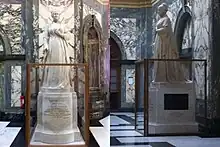 |
Elizabeth Fry | Old Bailey, London | 1913 | Statue on pedestal | Marble | [47] | |||
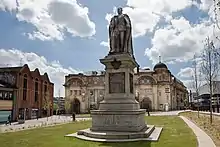 More images |
Edward VII | Fitzalan Square, Sheffield | 1913 | Statue on pedestal | Bronze and granite | Grade II | Q26560636 | [48] | |
 More images |
Edward VII | Union Terrace, Aberdeen | 1914 | Statue on pedestal | Granite | Category B | Q17770122 | Pedestal by A.G.R. Mackenzie[49] | |
.jpg.webp) |
Charles Kingston | Victoria Square, Adelaide, Australia | 1916 | Statue on pedestal | Bronze and marble | [50] |
1920–1931
| Image | Title / subject | Location and coordinates |
Date | Type | Material | Dimensions | Designation | Wikidata | Notes |
|---|---|---|---|---|---|---|---|---|---|
 More images |
London Troops War Memorial | Royal Exchange, London | 1920 | Column with statues | Stone and bronze | Grade II* | Q18575165 | [3][21][51][52] | |
 More images |
War memorial | Outside of St Mary's Church, Kidderminster | 1922 | Statue on pedestal with relief plaque | Bronze and limestone | Grade II | Q26671170 | [53][54] | |
 More images |
War memorial | Parliament Square, Hertford, Hertfordshire | 1922 | Sculpture on pedestal | Bronze and Portland stone | Grade II | Q26559085 | Architect, Aston Webb[55][56] | |
 More images |
War memorial | Grove Park, Weston-super-Mare | 1922 | Statue on pedestal | Bronze and stone | Grade II | Q26677665 | [57][58] | |
| War memorial | Lonsdale Quadrangle, Denstone College, Uttoxeter | 1925 | Statue of St George on pedestal | Bronze and stone | Grade II | Q26524254 | Architect, Aston Webb[59][60] | ||
 More images |
Statue of Joshua Reynolds | Courtyard of Burlington House, London | 1931 | Statue on pedestal | Bronze and stone | 2.9m tall | Grade II | Q18123341 | [21][61][62][63] |
Other works
- The Boer War Memorial, a plaque in deep relief, in the Cloisters at New College, Oxford
- Rhodes University (Grahamstown) War Memorial to the 1914-1918 and 1939-1945 conflicts, depicting a medieval knight in armour and chain mail, with gauntletted hands resting on the hilt of his sword.
- Two relief panels and two spandrels in marble, 1916, representing the Golden Jubilee of Queen Victoria, the Queen's proclamation of 1858, Industry and Commerce for the Victoria Memorial, Kolkata[64]
References
- 1 2 3 4 5 University of Glasgow History of Art / HATII (2011). "Alfred Drury". Mapping the Practice and Profession of Sculpture in Britain & Ireland 1851–1951. Retrieved 20 December 2020.
- 1 2 3 4 5 6 7 8 9 10 11 12 13 14 15 16 17 18 19 20 21 22 23 Susan Beattie (1983). The New Sculpture. Paul Mellon Centre for Studies in British Art / Yale University Press. ISBN 0300033591.
- 1 2 3 4 Mark Quinlan (2007). Sculptors and Architects of Remembrance. Sandy, Authors Online. ISBN 978-0755203-98-7.
- 1 2 3 Martina Droth, Jason Edwards & Michael Hatt (2014). Sculpture Victorious: Art in the Age of Invention, 1837-1901. Yale Center for British Art, Yale University Press. ISBN 9780300208030.
- ↑ James Mackay (1977). The Dictionary of Western Sculptors in Bronze. Antique Collectors' Club. ISBN 0902028553.
- ↑ Ian Chilvers (2004). The Oxford Dictionary of Art. Oxford University Press. ISBN 0-19-860476-9.
- ↑ "Bronze Panel". The Courtauld Institute of Art. Retrieved 13 December 2022.
- 1 2 3 "The Age of Innocence". Victoria and Albert Museum. 1897. Retrieved 21 December 2020.
- ↑ "Electra House (now part of the London Guildhall University)". The Victorian Web. 24 July 2011. Retrieved 21 December 2020.
- ↑ "Sculpture, Royal London House". The Courtauld Institute of Art. Retrieved 13 December 2022.
- ↑ "Keystone to New Buildings Royal London Friendly Society". Academy Architecture 1904–1908. Royal Academy. Retrieved 21 December 2020.
- ↑ "Pediment , sculpture Old War Office". The Courtauld Institute of Art. Retrieved 13 December 2022.
- 1 2 3 4 5 "A grand entrance on Cromwell Road". Victoria & Albert Museum. Retrieved 22 December 2020.
- ↑ "Lilith, 1916 Alfred Drury RA (1856–1944)". Royal Academy. Retrieved 21 December 2020.
- ↑ Frances Spalding (1990). 20th Century Painters and Sculptors. Antique Collectors' Club. ISBN 1-85149-106-6.
- 1 2 "Alfred Drury (1856–1944)". Royal Society of Sculptors. Retrieved 21 October 2021.
- ↑ "Settlement and building: Artists and Chelsea Pages 102-106 A History of the County of Middlesex: Volume 12, Chelsea". British History Online. Victoria County History, 2004. Retrieved 21 December 2022.
- ↑ "Alfred Drury, 88, British Sculptor. Londoner, Noted for Statue of Sir Joshua Reynolds, Dies. Works Seen by Millions". The New York Times. 25 December 1944. Retrieved 2 March 2015.
- ↑ Mark Stocker (2004). Drury, (Edward) Alfred Briscoe (1856–1944). Oxford University Press.
{{cite book}}:|work=ignored (help) - 1 2 Diane Bilbey with Marjorie Trusted (2002). British Sculpture 1470 to 2000 A Concise Catalogue of the Collection at the Victoria and Albert Museum. V&A Publications. ISBN 1851773959.
- 1 2 3 4 5 6 7 8 9 10 Jo Darke (1991). The Monument Guide to England and Wales. Macdonald Illustrated. ISBN 0-356-17609-6.
- ↑ Historic England. "Statue of Circe at West End of Central Garden (1375465)". National Heritage List for England. Retrieved 25 December 2020.
- ↑ Historic England. "Gatepiers, Gates and series of 12 Pillars forming west boundary wall of formal garden at Barrow Court (1129171)". National Heritage List for England. Retrieved 20 December 2020.
- ↑ Historic England. "Monument in Victoria Gardens (1329249)". National Heritage List for England. Retrieved 14 December 2022.
- ↑ "Sir William Penn Symons monument". Art UK. Retrieved 13 December 2022.
- ↑ Historic England. "Statue of Joseph Priestley (1375043)". National Heritage List for England. Retrieved 18 December 2020.
- ↑ Historic England. "Four lamp posts: 'Even' (1255575)". National Heritage List for England. Retrieved 18 December 2020.
- ↑ Historic England. "Four lamp posts: 'Morn' (1375012)". National Heritage List for England. Retrieved 18 December 2020.
- ↑ Historic England. "Royal Arsenal Cooperative Society Headquarters Building (1289022)". National Heritage List for England. Retrieved 18 December 2020.
- ↑ "Alexander McLeod". Vads / Public Monuments and Sculpture Association. Retrieved 31 December 2020.
- ↑ Historic England. "Statue of Queen Victoria (1104315)". National Heritage List for England. Retrieved 18 December 2020.
- ↑ Historic England. "Clifton College, South African War Memorial (1282343)". National Heritage List for England. Retrieved 18 December 2020.
- ↑ "War Memorials Register: Clifton College - Boer War". Imperial War Museum. Retrieved 18 December 2020.
- ↑ "Boer War Memorial". The Courtauld Institute of Art. Retrieved 13 December 2022.
- 1 2 A User's Guide to Public Sculpture. English Heritage / PMSA. 2000. ISBN 185074776-8.
- ↑ Historic England. "Victoria Memorial (1132899)". National Heritage List for England. Retrieved 18 December 2020.
- ↑ "Bust of Lord Byron". The Courtauld Institute of Art. Retrieved 13 December 2022.
- ↑ "Queen Victoria Monument". New Zealand Heritage List/Rārangi Kōrero. Heritage New Zealand. Retrieved 17 January 2021.
- ↑ "Statue of Queen Victoria 1905". Yale Centre for British Art. Retrieved 23 January 2021.
- ↑ Historic England. "Vauxhall Bridge (1393011)". National Heritage List for England. Retrieved 18 December 2020.
- ↑ Historic England. "Statue of Bishop Hooker (1104024)". National Heritage List for England. Retrieved 18 December 2020.
- ↑ "War Memorials Register:South Lancashire Regiment Second Boer War". Imperial War Museum. Retrieved 19 December 2020.
- ↑ Historic England. "War Memorial to South Lancashire Regiment in Queen's Gardens (1329723)". National Heritage List for England. Retrieved 19 December 2020.
- ↑ "Boer War Memorial". The Courtauld Institute of Art. Retrieved 13 December 2022.
- ↑ "Statue, Gateposts at the Victoria Memorial Complex". The Courtauld Institute of Art. Retrieved 13 December 2022.
- ↑ Historic England. "Statue of Spencer Cavendish, Eighth Duke of Devonshire KG (1833/1908) Mayor of Eastbourne 1897/98 (1353136)". National Heritage List for England. Retrieved 18 December 2020.
- ↑ "Memorial to Elizabeth Fry". The Courtauld Institute of Art. Retrieved 13 December 2022.
- ↑ Historic England. "Statue of King Edward VII (1270597)". National Heritage List for England. Retrieved 19 December 2020.
- ↑ Historic Environment Scotland. "Edward VII, Statue, Junction of Union Street and Union Terrace (Category B Listed Building) (LB20004)". Retrieved 18 December 2020.
- ↑ Jude Elton (26 May 1916). "Charles Cameron Kingston Memorial". Adelaidia. Retrieved 19 December 2020.
- ↑ Historic England. "The City and County of London Troops War Memorial, Non Civil Parish (1064714)". National Heritage List for England. Retrieved 18 December 2020.
- ↑ "War Memorials Register: Men of the City and County of London". Imperial War Museum. Retrieved 18 December 2020.
- ↑ Historic England. "Sculpture of the Angel of Peace at St Mary and All Saints Church (1391825)". National Heritage List for England. Retrieved 31 December 2020.
- ↑ "War Memorials Register: Kidderminster". Imperial War Museum. Retrieved 31 December 2020.
- ↑ Historic England. "Hertford War Memorial includingraised elliptical surround (1268806)". National Heritage List for England. Retrieved 18 December 2020.
- ↑ "War Memorials Register: Hertford WW1 and WW2". Imperial War Museum. Retrieved 18 December 2020.
- ↑ Historic England. "Grove Park War Memorial, Weston-super-Mare (1430882)". National Heritage List for England. Retrieved 19 December 2020.
- ↑ "War Memorials Register: Weston Super Mare, Uphill and Kewstoke". Imperial War Museum. Retrieved 19 December 2020.
- ↑ "War Memorials Register: Denstone College WW1 Figure". Imperial War Museum. Retrieved 19 December 2020.
- ↑ Historic England. "War Memorial South West of Denstone College (1230583)". National Heritage List for England. Retrieved 31 May 2021.
- ↑ Historic England. "Statue of Sir Joshua Reynolds in Burlington House Courtyard (1226714)". National Heritage List for England. Retrieved 18 December 2020.
- ↑ John Blackwood (1989). London's Immortels. The Complete Outdoor Commemorative Statues. Savoy Press. ISBN 0951429604.
- ↑ "Statue of Sir Joshua Reynolds". The Courtauld Institute of Art. Retrieved 13 December 2022.
- ↑ Mary Ann Steggles & Richard Barnes (2011). British Sculpture in India: New Views & Old Memories. Frontier Publishing. ISBN 9781872914411.